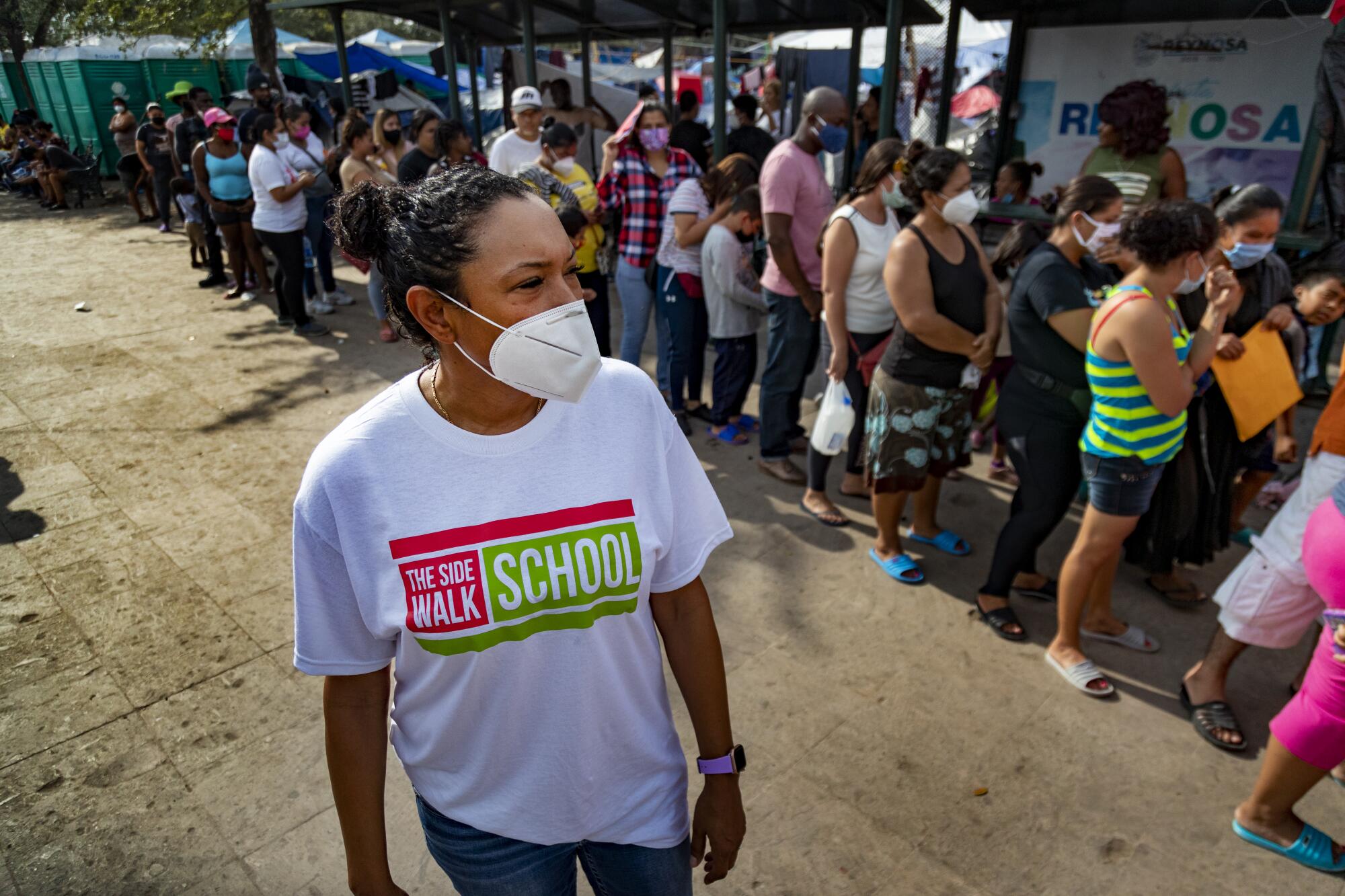
- Share via
REYNOSA, Mexico — So much of her is hyphenated, not just her name: Felicia Rangel-Samponaro. With caramel skin and curly brown hair that’s often tied back, she can pass as Latina.
But she identifies as Black.
On the Texas-Mexico border, she’s emerged as a vigorous defender of immigrants, and that work often forces her to reckon with how race and ethnicity — real and perceived — shape lives on the border, including her own.
“There’s a lot of oppression, discrimination and racism that goes on, on both sides of the border,” she said.
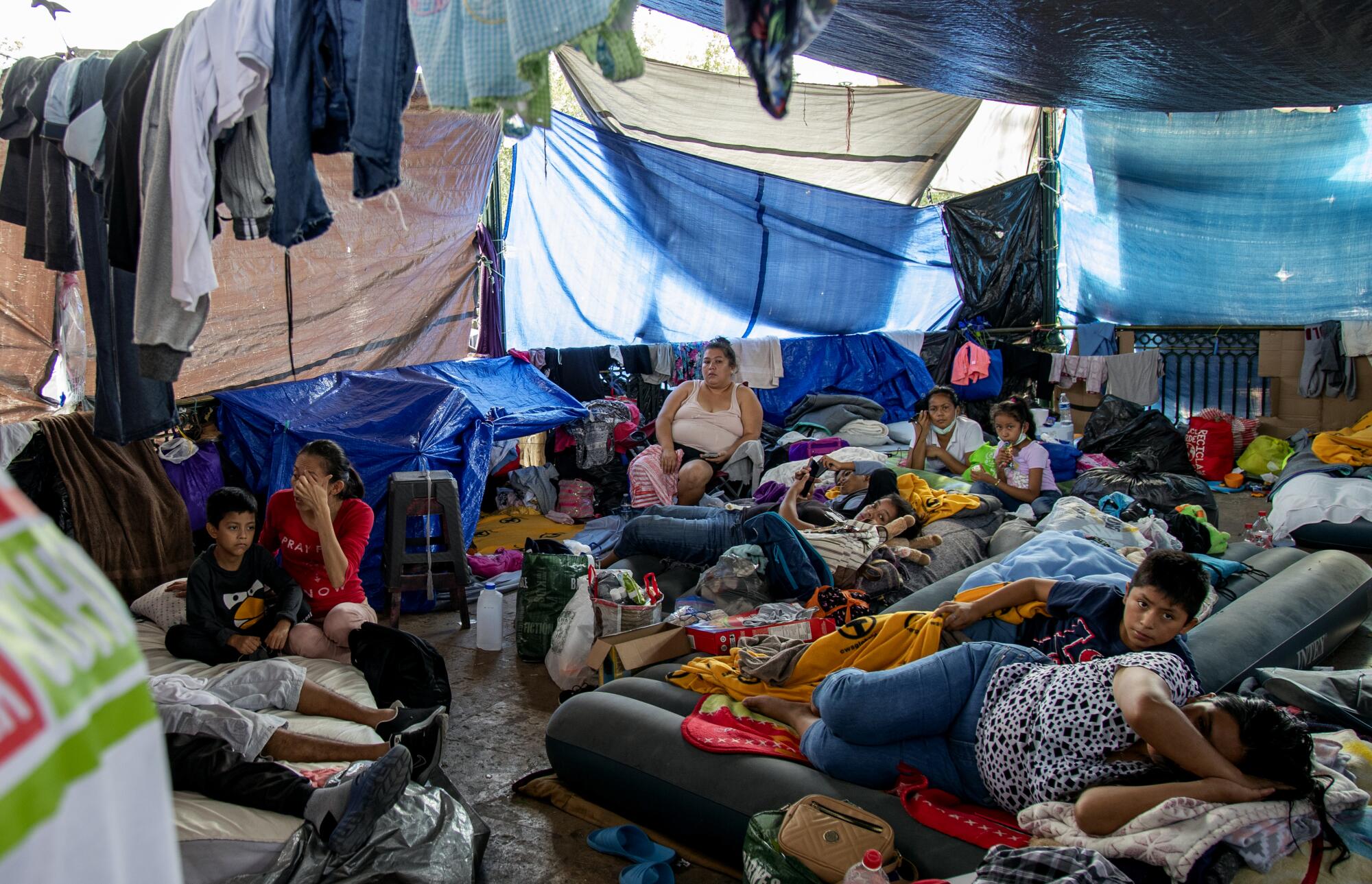
Rangel-Samponaro’s background has allowed the 45-year-old American to win over skeptics who find they can relate to her, sometimes as Black, sometimes as Latino.
But being a Black border activist is still challenging.
Sometimes, it means getting detained by U.S. Customs, then subjected to a cavity search. Other times, it means confronting Central American migrants cracking racist jokes or correcting people on both sides of the border who assume her white male employee is her boss.
Immigration was not at the forefront of her mind when groups of asylum seekers appeared here three years ago. She was a suburban stay-at-home mom living in the border city of Brownsville with a son in private school. She wore pricy Lululemon activewear, drove a Mercedes and, in her spare time, played Pokemon.
A fellow Pokemon player’s Facebook post about delivering donations to migrants camped on a border bridge spurred her to volunteer. She had crossed to Mexico a handful of times, like many Texans, as a tourist. That first winter day volunteering, she was struck by a new sight: shivering migrants in crisis.
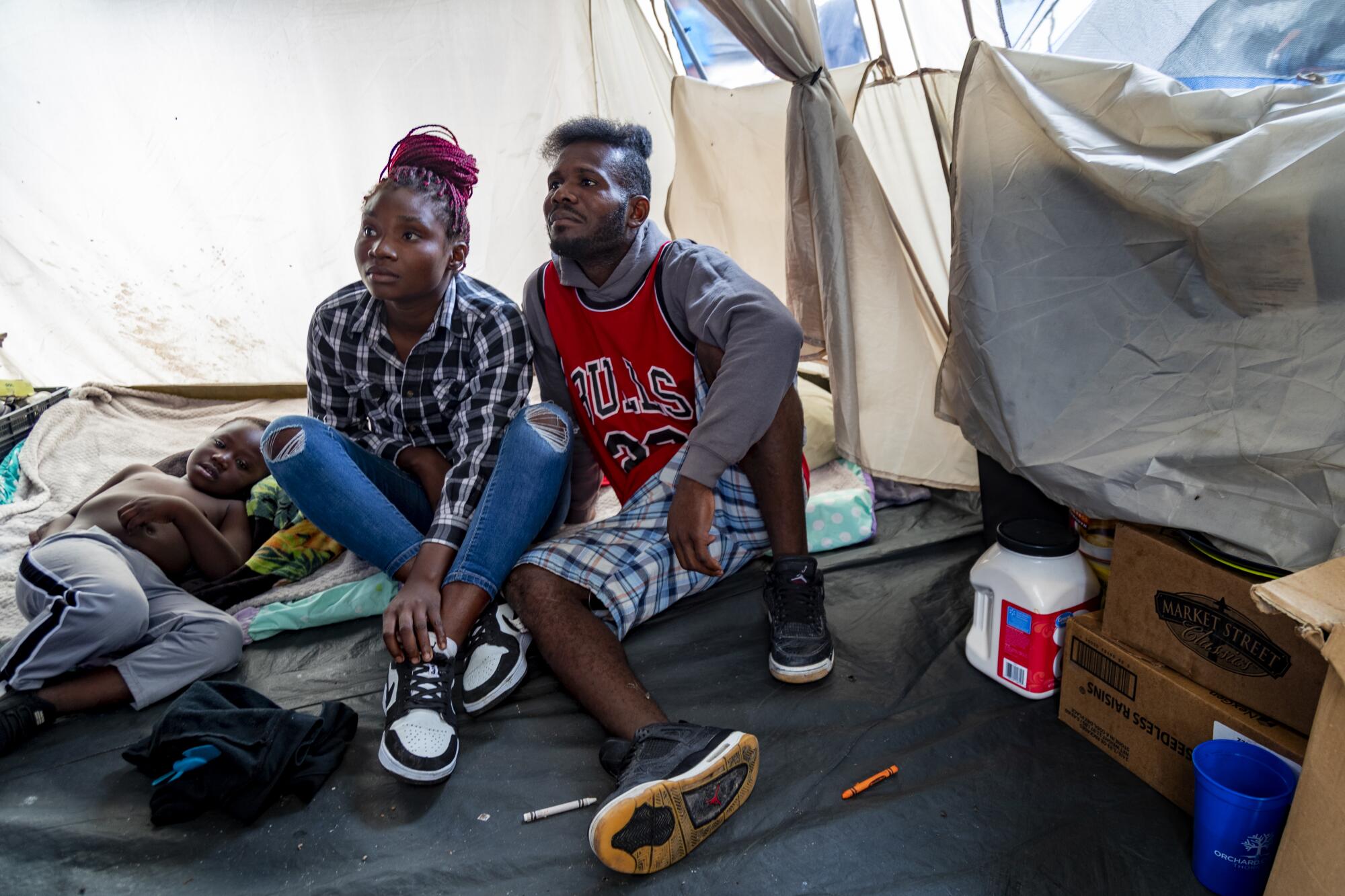
“It was a hard thing, and it’s still the hard thing for me to just turn my back to and then continue my life,” she said. “…It just put a lot of things in perspective.”
Ethnicity and race can overlap, and in the months that followed, she noticed how many of the migrants looked like her, some from Africa. Volunteering with the migrants soon consumed her. Her husband didn’t share her fervor. Within a year, they had divorced. Rangel-Samponaro transferred her son to public school, traded her Mercedes for a Honda, Lululemon for jeans and T-shirts that said, “Protect Black Migrants.”
She started a nonprofit, the Sidewalk School, working with fellow volunteer Victor Cavazos, paying asylum seekers to teach migrant children at border camps.
“I used my life savings the first year to keep my organization afloat,” she said, later winning grants, creating an Etsy shop for migrants to sell their art, and connecting them with immigration lawyers.
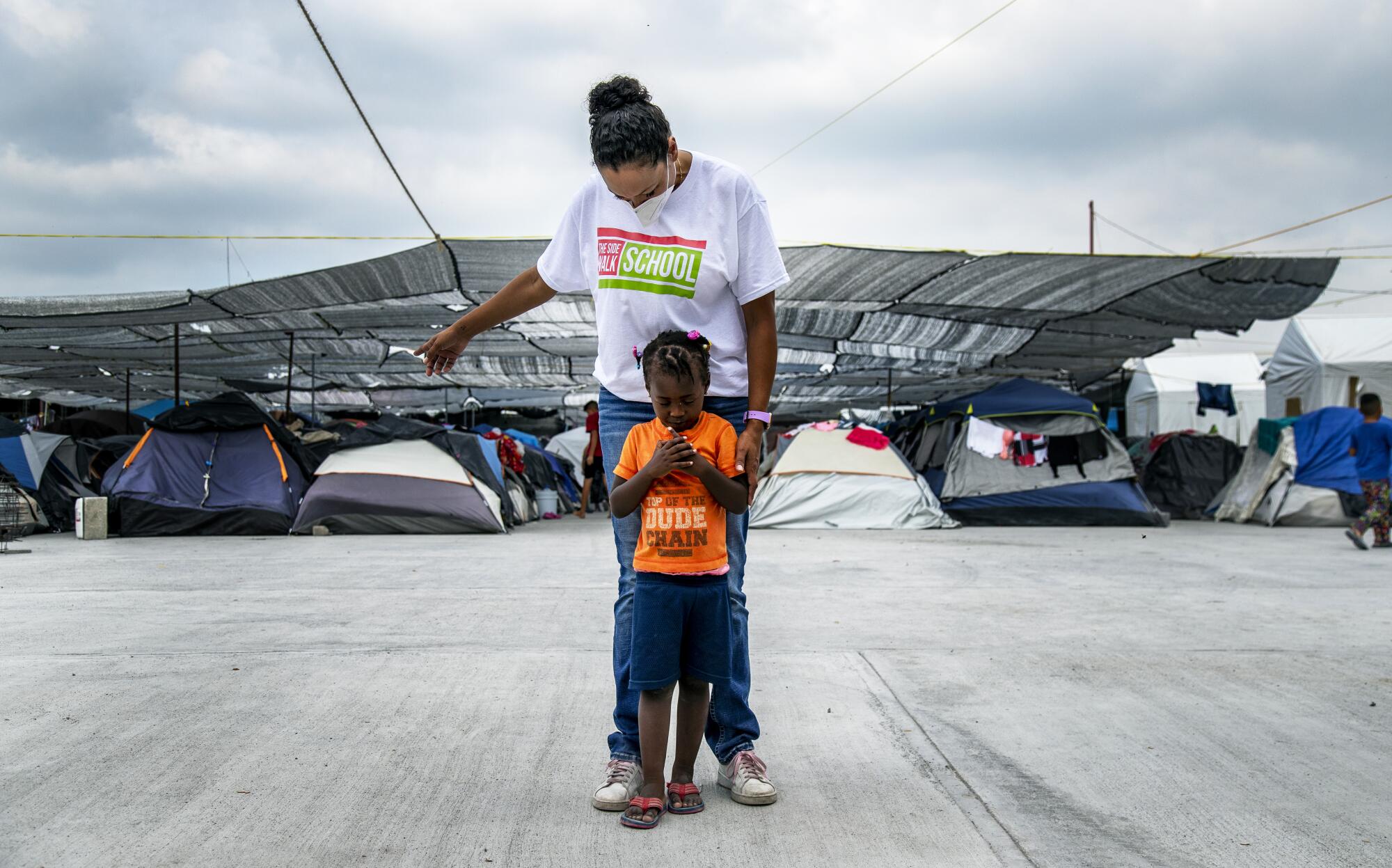
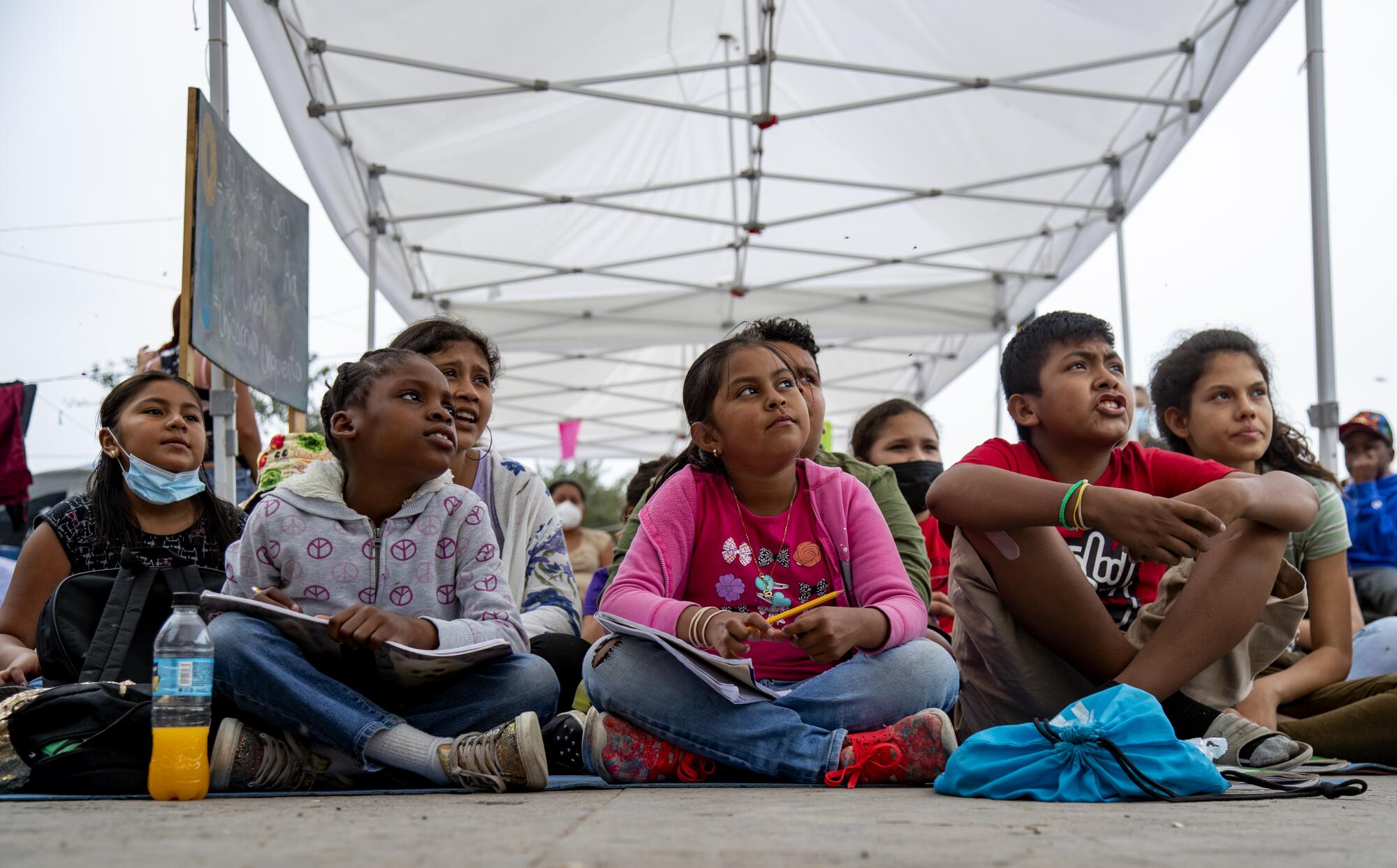
Now she’s one of the few American volunteers willing to cross to Reynosa, a dangerous border town where thousands of migrants have camped. Although volunteers from Black churches and Haitian activists appeared in the fall to help a caravan of Haitian migrants, they soon vanished. Rangel-Samponaro remained, championing immigrants, particularly Black migrants beset by discrimination she knew all too well.
“We are few and far between that rise up out of what is holding us down — which is America,” she said.
Brendon Tucker, project manager for nonprofit Global Response Management, which runs clinics at the Reynosa camp, has worked with Rangel-Samponaro for years on the border.
“For Reynosa, she really laid the groundwork for us to get involved,” he said, recounting how she introduced him to local migrant advocates.
They share a commitment to migrants, he said.
“Our country fueled a lot of these problems. This was done in our names,” he said, “and we all feel a sense of duty.”
Rangel-Samponaro’s mother is Black, raised in the Rio Grande Valley farming town of Kingsville, where she and her siblings picked cotton. Her mother is so fair, people often assume she is white. Once at a nightclub in the 1980s, Black women surrounded her because they thought she was white and dating a Black man. Another time, a group of white men threatened to kill her Black boyfriend.
But her mother never tried to “pass” as white. At the movies, she still sat in the segregated balcony.
“We grew up knowing we are Black, and that’s how people will always see us,” said Rangel-Samponaro, who has two older sisters. “Who my father was never mattered.”
Her father was the son of Mexican migrants who crossed illegally into Texas and settled in Austin. That’s where her parents met while he worked for the city fixing stoplights.
Perceptions of race, and who should mix with who, led to his death in 1977, when she was a year old.
Her father was hanging out in Austin with his brother, whose girlfriend was Black. A Black man warned her uncle that his Black girlfriend “should stick to her own kind.” They fought. Rangel-Samponaro’s father got involved and the man fatally shot him.
Her mother put herself through nursing school and settled the family in a middle-class Houston neighborhood, where some still assumed she was white.
Unlike their mother, Rangel-Samponaro and her sisters stood out as biracial.
“We were bullied by white girls and by Mexican girls because we didn’t fit in,” she said.
She never learned Spanish because her father had made her mother promise to raise their daughters, as many Tejanos did at the time, speaking only English.
“He wanted us to be true Americans,” she said.
For her work in Mexico, Rangel-Samponaro relies on friends and staff to translate. She grew up surrounded by Black relatives who were darker skinned and didn’t meet her father’s family until she was an adult, she said, “Which is why I identify as a Black woman.”
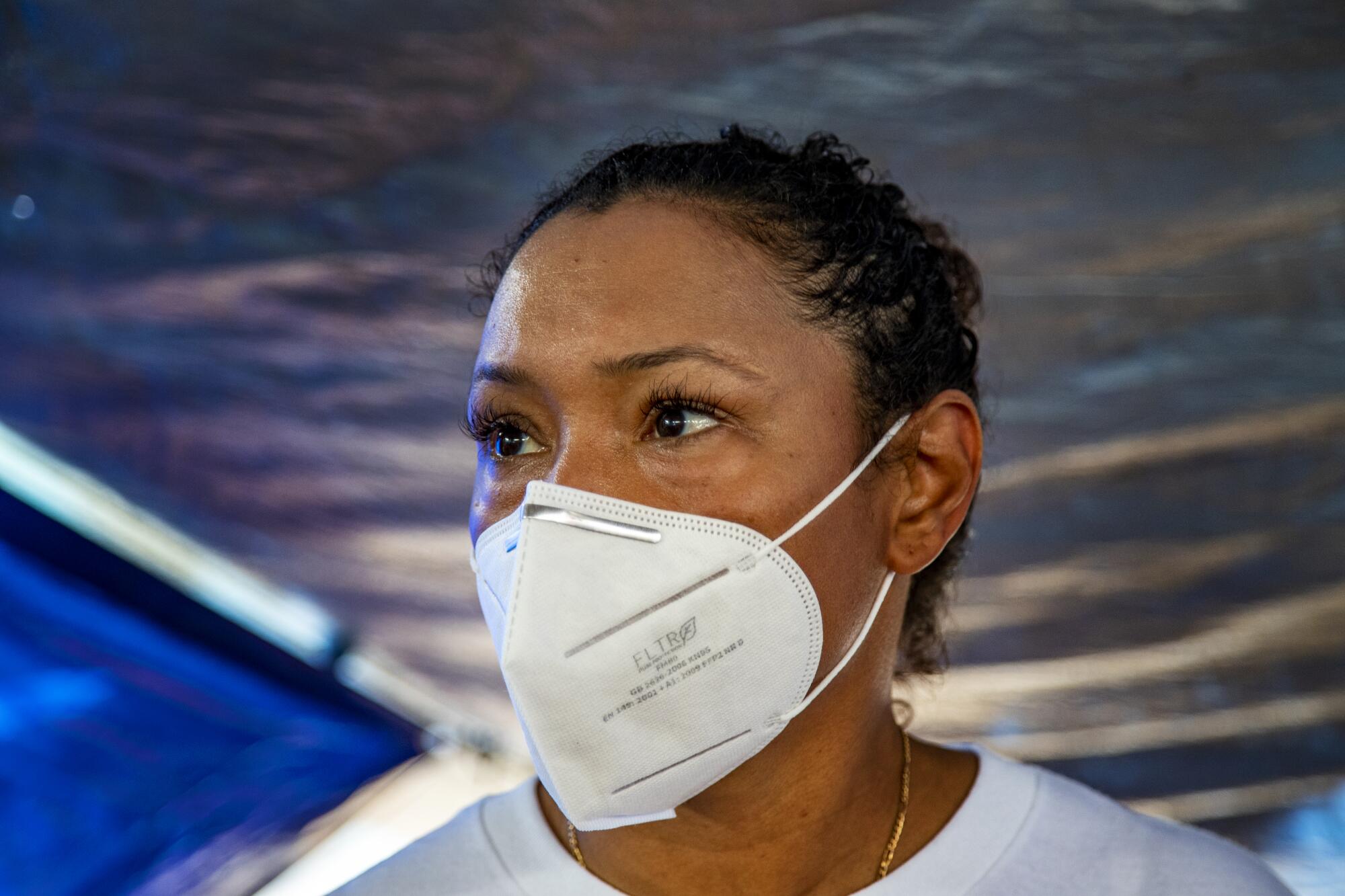
Her mother didn’t talk about their background, but encouraged the girls to read widely. When she was in sixth grade, Rangel-Samponaro read “The Autobiography of Malcolm X” at home because it wasn’t taught in school, and was struck by the racism he faced as a light-skinned Black man. She read “Tar Baby,” “A Raisin in the Sun,” and books by Sister Souljah and Iceberg Slim but also Ayn Rand and even “Mein Kampf.”
“I just like to know what makes people tick,” she said.
Her older sisters both earned advanced degrees. She followed in their footsteps, graduating from the University of Houston and starting graduate school in marriage and family counseling as she taught elementary school.
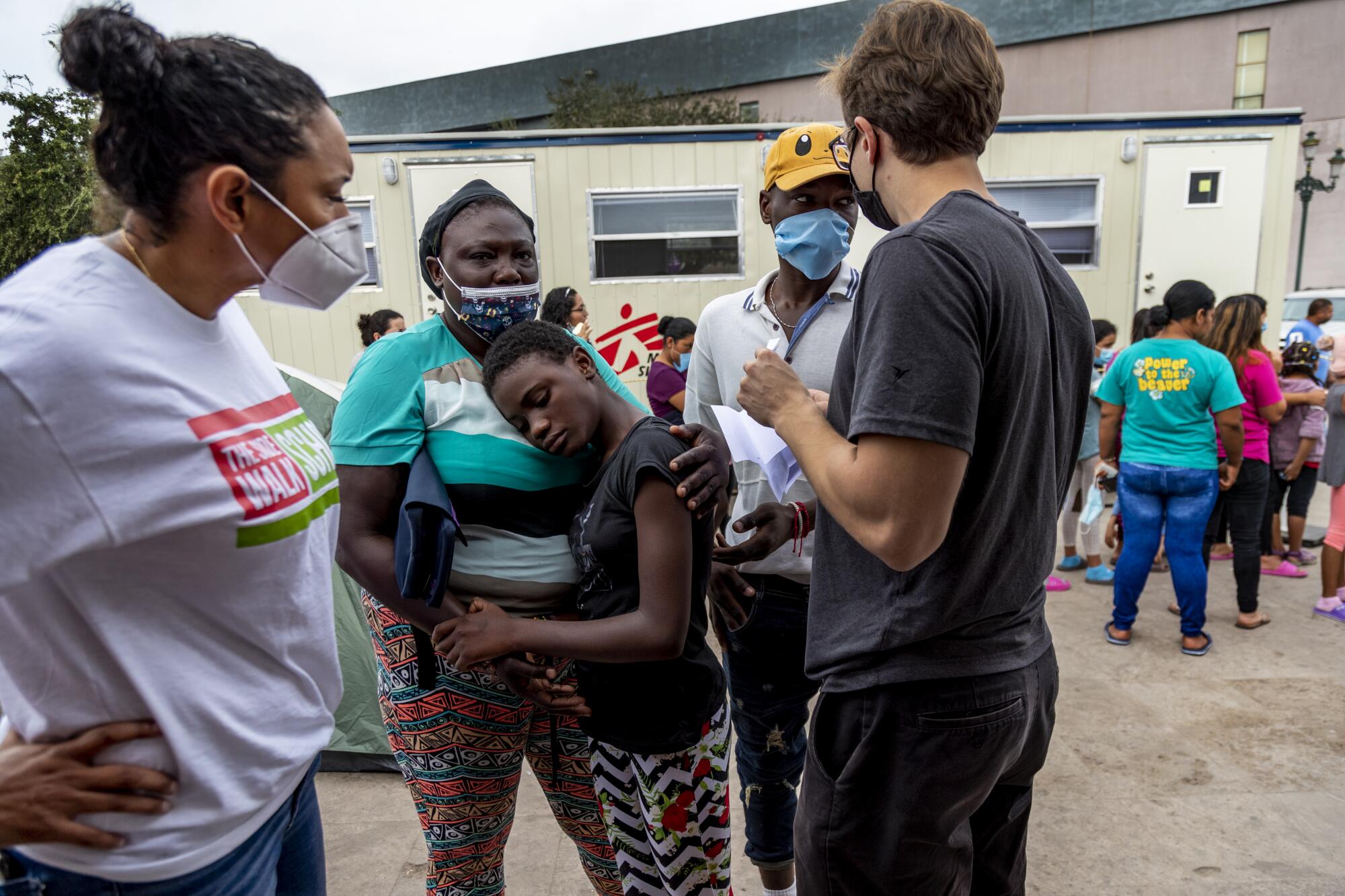
She met her husband, a white man from Connecticut, and within a year had a son. Soon after, her husband was offered a university teaching job in the Rio Grande Valley, where her father’s parents had crossed the border and her mother had been raised.
The transition was painful. When she crossed to Mexico with her extended family, vendors approached only her and her mother — she assumes because they were light skinned. On the U.S. side, locals assumed she was Black.
“I’ve never been called the N-word so much until I moved here,” she said. “Which was actually pretty surprising coming from other minorities, which I would also tell them as well, ‘From one minority to the other: You should be ashamed of yourself.’”
She told Latinos who hurled such slurs that they might become targets of bigotry themselves.
“I always let them know: Once you leave your little bubble of the Valley, and if you ever went to Houston or another major city here in the U.S., you will be looked upon the same way you are looking at me.”
As her son grew, he noticed how some locals treated her.
“He asked me yesterday when we were leaving Walmart, why was I stopped over everyone else, and I was honest, ‘It’s because I’m Black. That’s why they stopped me. They think I steal.’ And he says, ‘Will they do that to me?’ and I said, ‘No, they won’t. You look white. They’ll let you pass,’” she said. “My mom didn’t have those conversations with me and my sisters. And I wish she had. So I’m very honest with my son.”
Her worst fear: That her son will pass as white, betraying their Black ancestors. It’s one thing if people assume he’s white, as they did with her mother. It’s quite another if he takes advantage by presenting himself that way.
“You never pass,” she said of the way she and her sisters were raised. “If we see a Black person passing, then there is immediate disgust.”
Passing as white would make it easier to work in Mexico, she said. White migrant advocates seem to automatically command respect from locals in Reynosa. But instead of passing, Rangel-Samponaro has tried to leverage being biracial.
When she tells Mexican officials about her father, they smile and give her high fives. When she tells them she’s Black, they’re surprised.
“In their minds, Black people don’t cross into Mexico to help others,” she said.
Black migrants usually assume she’s Latina. So she makes a point of saying that she identifies as Black and that, “We are going through the same struggles.”
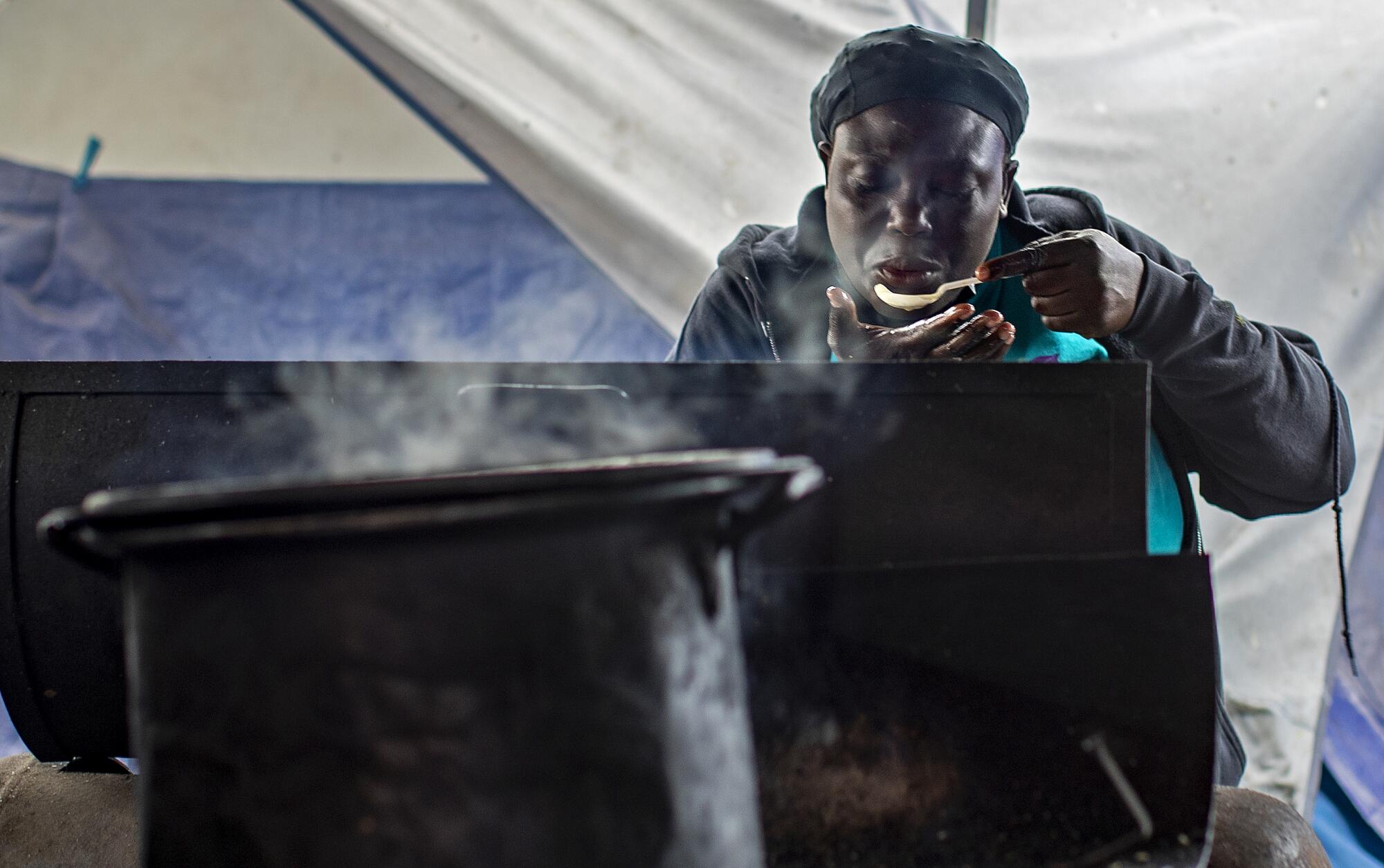
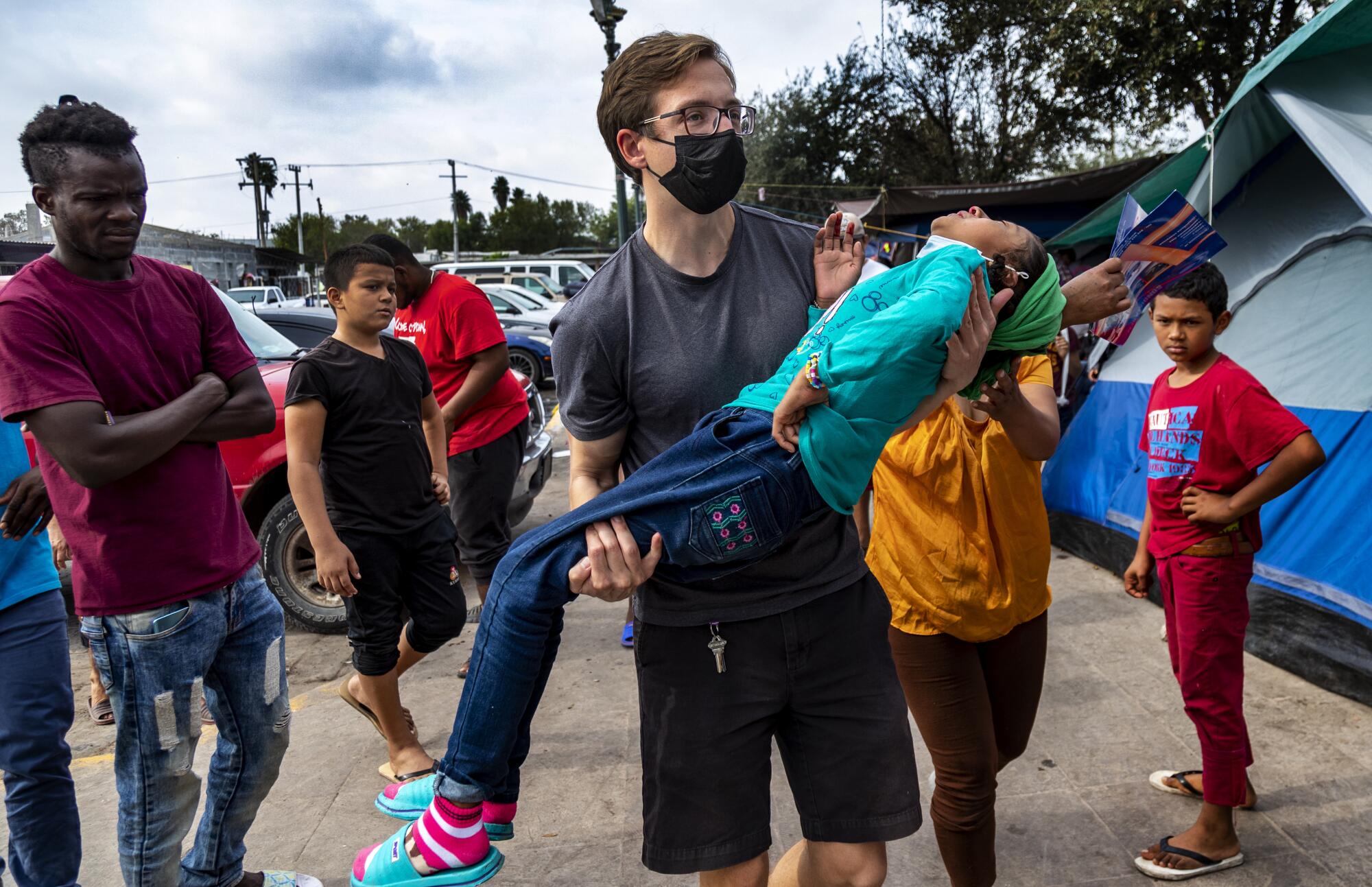
Among Latino migrants, she’s learned to recognize when they use Spanish racial slurs and stops them, patiently explaining that it’s offensive because she’s Black. For her, it’s a teachable moment.
“To a lot of them, being Black is like the lowest thing you can be,” she said. “…I’m their first contact with a Black person, and this Black person is paying your rent, feeding you and your family, providing education to your child. So I hope over the years I’ve changed the opinion of some.”
Earlier this month, Rangel-Samponaro strode through the migrant camp, past her school, where a dozen children sat on mats in front of blackboards, reciting English phrases as their parents stood nearby, a mix of Black and Latino migrants.
She passed the camp’s nonprofit clinic, where the line had swelled to over a hundred, including several Haitians: A woman who suffered a miscarriage days before, a 10-year-old girl with an umbilical hernia and a couple with sickle cell anemia. Rangel-Samponaro’s group would connect the sickest with a U.S. immigration lawyer.
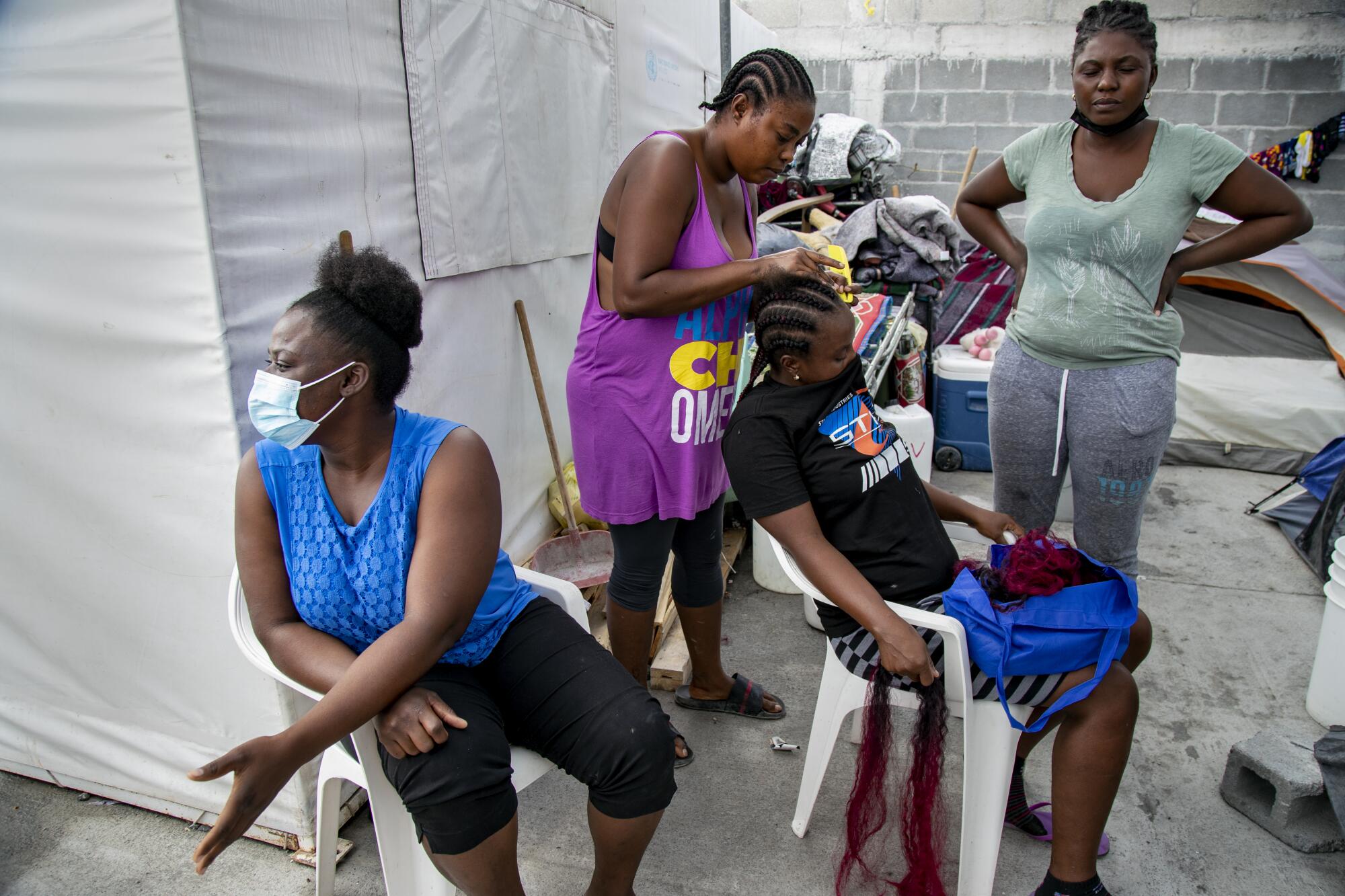
“Word has gotten out that we take serious medical cases, so now everyone has a serious medical problem,” she said.
Asylum seekers were desperate to escape the camp. As it expanded this year to more than 2,000, it became more dangerous. Migrants had been kidnapped, assaulted, raped and robbed, including Haitians targeted by migrant neighbors.
“They steal their food; they take their tents; they take their beds,” Rangel-Samponaro said. “Because they’re Black, they feel like this is OK to treat them that way.”
Rangel-Samponaro stopped at the back of the camp where Haitians lived, at a makeshift kitchen where they cook. A woman was preparing soup, chopping yams and green beans supplied by Rangel-Samponaro.
Many local stores won’t sell to Black migrants, she said. Employers won’t hire them, taxis won’t drive them and landlords refuse to rent to them. So Rangel-Samponaro does it for them, and locals assume she’s Latina. It’s the one instance where she passes for the sake of her work.
“I never say I’m Mexican even though I am,” she said. “It would be the same as if I was trying to pass as white. Passing is passing.”
She’s rented apartments for about 20 Haitian migrants elsewhere in Reynosa, but even when she’s passing as Latina, her power to help Black migrants in Mexico is limited.
When she picked up several Haitian families walking outside Reynosa in the fall, planning to drive them into the city, she was stopped by Mexican soldiers. They took the families into custody, threatened to detain her and sent the migrants to the southern state of Veracruz, where she wired them money for food and lodging.
She blamed deteriorating conditions at the camp on the Mexican government and Biden administration, which extended a Trump pandemic policy that bars many migrants from seeking asylum.
“They need Title 42 to keep Black asylum seekers out,” she said recently as she waited on the border bridge to return to the U.S., referring to the public health law invoked by the Trump administration.
She was nervous as she approached U.S. Customs. It had been months since officers stopped her while she was crossing with fellow volunteer Cavazos, but she was still shaken.
She had never been stopped on the bridge before, never had her car searched and X-rayed — twice. Then she was escorted inside the customs office and cavity searched by two Latina officers as a Latino supervisor watched.
Rangel-Samponaro could tell the officers suspected she had drugs in her Honda SUV. It felt like racial profiling. On video she recorded with her phone until officers confiscated it, she shouts, “You only searched me because we’re minorities!”
“I told them, ‘You’re doing it to your own people,’” she said.
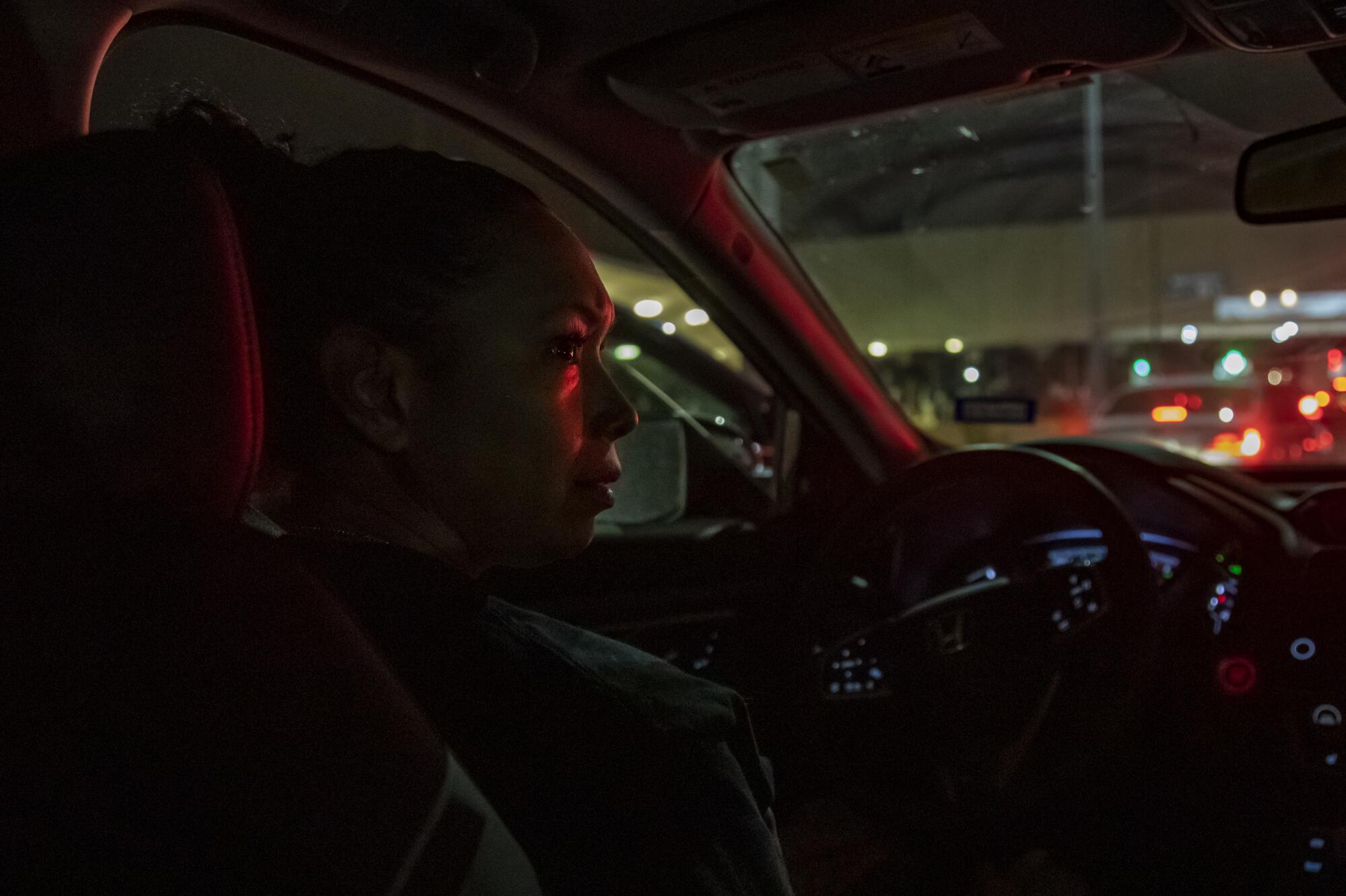
She and Cavazos were ultimately released and not accused of wrongdoing. The next day, she contacted a U.S. Customs official she knows. He apologized and emailed her a form in case she wanted to file a complaint. She didn’t.
“I don’t want to make it worse,” she said, satisfied the officers’ actions were scrutinized. “He did investigate it and I know those people heard about it.”
As for the future, last week, Rangel-Samponaro started building her own migrant shelter in Reynosa. Mexican officials initially said she would be able to accept only Central American families, but she insisted on housing Black migrants too.
“People are uncomfortable when I call out the racism, but imagine how I feel?” she said. “I’m uncomfortable all of the time. So no, I have no sympathy for people who are feeling uncomfortable because I am calling it what it is. You should be uncomfortable, and maybe then you’ll stop or tell your friend to stop.”
More to Read
Sign up for Essential California
The most important California stories and recommendations in your inbox every morning.
You may occasionally receive promotional content from the Los Angeles Times.










